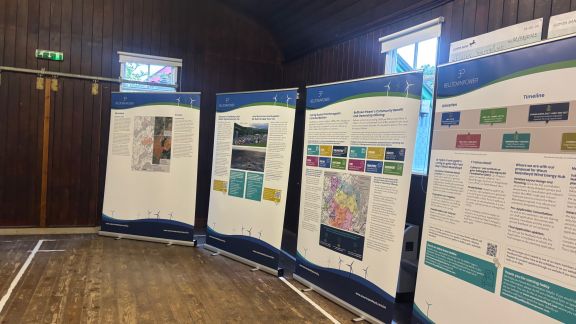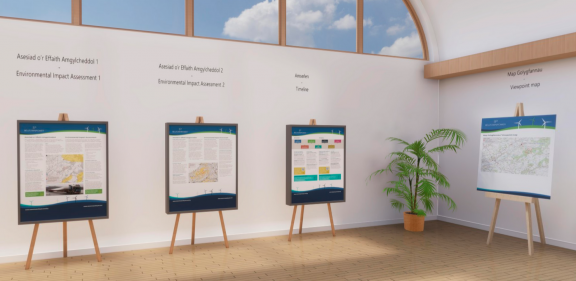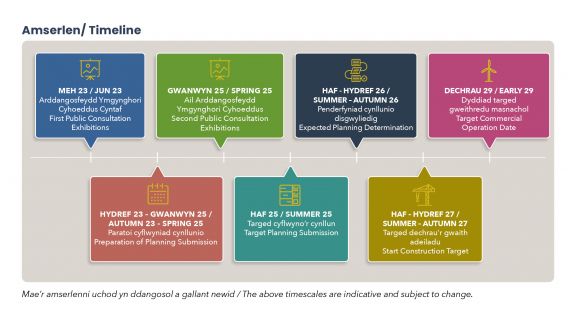Welcome to our website for the Waun Maenllwyd Wind Energy Hub
At Belltown Power we are committed to working with local communities and stakeholders to responsibly develop renewable energy projects that help to deliver Wales' and the UK’s climate change targets and ensure a green and sustainable future for generations to come.
The Waun Maenllwyd proposal is for up to 6 turbines, situated approximately 3.5km southeast of Llanddewi Brefi. There is no battery storage or solar proposed, and the grid connection would be via wooden pole line to Lampeter, not requiring any new pylons. For more information about the project, see Project Proposal.
The Pre-Application Consultation period ran from 17 September - 4 December 2025 and is now closed. Thank you to everyone who took part for your valuable feedback, which will be recorded as part of our application.

Need for Onshore Wind
The Climate Crisis
We are facing an unprecedented global climate crisis caused by the use of fossil fuels to power our societies. In Wales, this is likely to mean:
- More frequent extreme rainfall and flooding, increasing by up to 30% this century
- Wetter, warmer winters, with average rainfall increasing by 14% by 2050
- Drier, hotter summers, with temperatures increasing by 3 degrees and rainfall decreasing by 16% on average by 2050 [1]
We need to urgently cut greenhouse gas emissions to prevent irreversible temperature rises and nature loss. Generating our electricity from renewable sources is vital.
Onshore wind offers one of the lowest costs of clean energy generation. Installing more onshore wind:
- helps tackle the climate emergency,
- keeps electricity prices low and stable, and
- helps the UK with energy security
Renewable Energy in Wales
In 2023, only 53% of Wales' domestic electricity consumption was generated by renewables.[2] As electrification of heating and transport continues, demand for electricity will rise. The Welsh Government has set a target to meet its electricity demand from renewable sources by 2035 and Waun Maenllwyd can make a valuable contribution to that.
Project Contribution
Waun Maenllwyd Wind Energy Hub has the potential to make a sizeable contribution to the decarbonisation of our electricity system and reduce our greenhouse gas emissions, by producing enough energy to power 28,500 homes a year.[3] That is equivalent to over three-quarters of the homes in Ceredigion.[4] This project is an opportunity for your community to contribute to tackling climate change in a significant way through hosting and part-owning a modern wind energy hub.
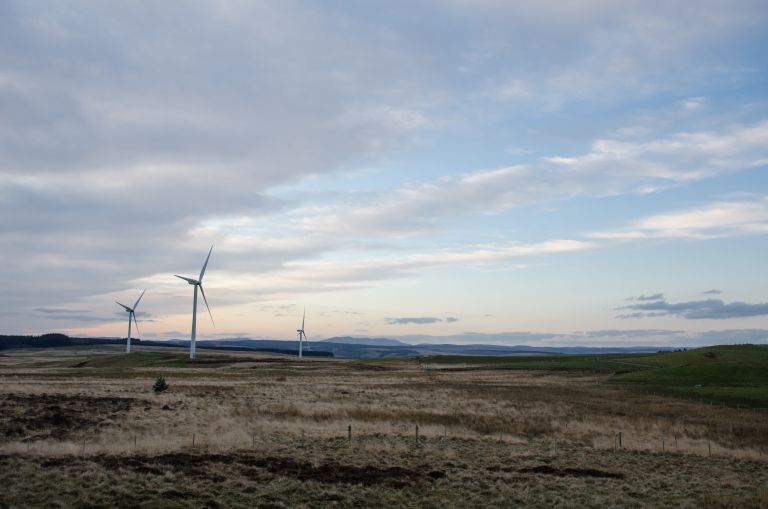
Project Proposal
The Site
The site is located in southeast Ceredigion adjacent to the northern Carmarthenshire border, approximately 3.5km southeast of Llanddewi Brefi and 13km northeast of Lampeter. The site is currently managed commercial forestry with some open moorland used for sheep grazing. Both these activities will continue alongside the development proposal.
The majority of the site is located within Area 6 of the Pre-Assessed Areas (PAA) defined in Future Wales: The National Plan 2040. [5] This means that there is a ‘presumption in favour of large-scale wind energy development’ in these areas, since the Welsh Government has ‘modelled the likely impact on the landscape and has found them of being capable of accommodating development in an acceptable way.’
The turbine layout comprises up to 6 turbines with tip heights up to 200m and 180m. These, together with extensive habitat enhancements, make up the Wind Energy Hub.
Design Evolution since First Consultation
Following feedback from the first consultation and Scoping Consultees we have revised the layout of the Waun Maenllwyd Wind Energy Hub:
- We have worked closely with our landscape architects to minimise the visual impact of the scheme
- The turbine locations have been adjusted to minimise impact on the environment, particularly peaty soils
- Tracks and infrastructure have been minimised to minimise tree felling
- We have reduced all tip heights, from 230m to:
- 200m for 5 turbines
- 180m for 1 turbine
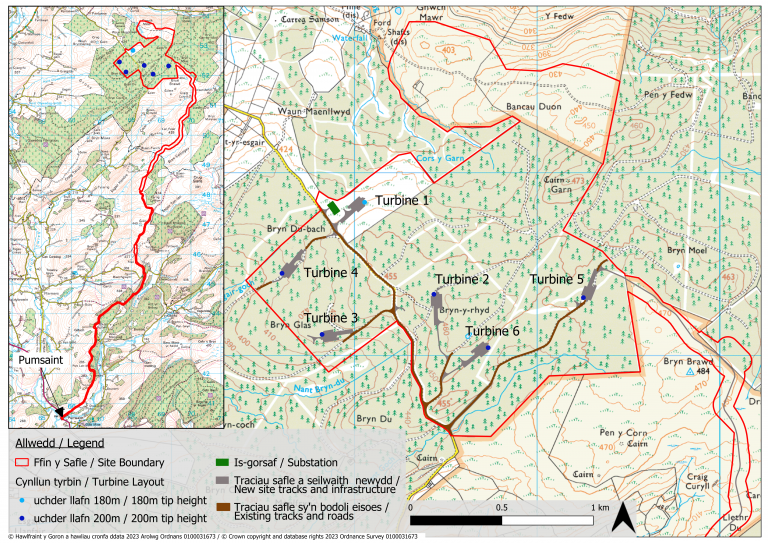
Habitat Enhancements
As well as generating clean green energy, the project would include significant habitat enhancements, including:
- Creating more Ponds, to create ‘stepping stone’ habitats for amphibians, invertebrates and water vole across the site.
- Forest to Bog: Commercial forestry felled for bat buffers around the turbines would be restored to its natural bog habitat, increasing peatland habitats on site
- Grassland Improvements, by increasing wildflower growth alongside continued grazing to improve the species-richness of the area
- Planting Native Trees, particularly along the Nant Goch and plantation edges, connecting habitats through the site and providing a range of benefits including
- permanent habitat connectivity for red squirrels,
- new foraging area for bats and other mammals
- shade and maintaining cool water for aquatic animals
- Enhancing nesting and roosting opportunities for wildlife on permanent native trees, by adding at least
- 10 bat boxes
- 15 bird boxes and
- 5 red squirrel (drey) boxes
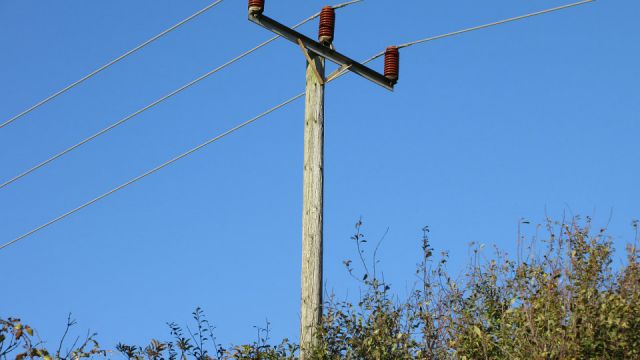
Grid Connection
The project has secured grid capacity, which would be via a new 33kV connection to Lampeter. The cable would be supported on wooden poles, like those already in the area. We have no proposals to erect large pylons as part of this project.
Access
The proposed access route to the site for abnormal indivisible loads (AILs) such as blades, hub, nacelle and tower sections is from the port at Swansea via the M4, A48 and A40 to Llandeilo, then turning left onto the B4302 via Talley before joining the A482 at Crugybar.
A blade lifter vehicle, which tilts the blades up to 60 degrees or more to safely navigate the tighter bends, would be used for some sections of the B4302. Parts of the road would also need widening slightly to accommodate the AILs. We would use a text alert service to keep residents up to date with scheduled deliveries and will work with Dyfed-Powys Police to minimise any disruption.
Pumsaint to Site
The route from Pumsaint to site is shown on the map above. A good quality forestry track already exists for the first 7km of the route, which we would resurface and widen in a few places to make it suitable for the AIL vehicles.
The new track required for the second part of the route has been carefully designed to ensure that important habitat areas and deep peat are avoided as much as possible.
Common Land
A short section of the proposed new access route traverses a small area of Common Land. We are working closely with those affected and will be making a separate application alongside the DNS application to de-register the access track area from the Common and replace it with equivalent areas of suitable replacement land. The draft Common Land Report and Application is available in the draft Planning Application Documents.
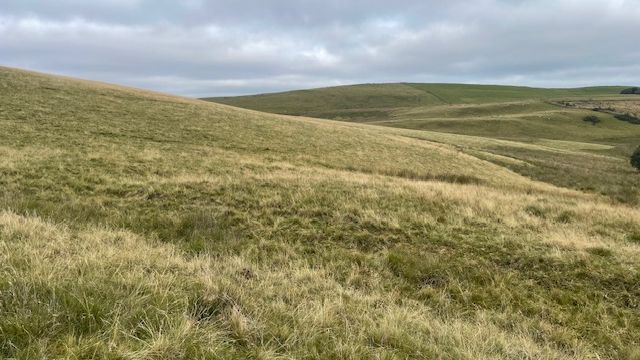
Planning Process
The project qualifies as a Development of National Significance (DNS), and as such the Planning Application will be ultimately determined by the Welsh Ministers.
The Pre-Application Consultation period ran from 17 September - 4 December 2025 and is now closed. Thank you to everyone who took part for your valuable feedback, which will be recorded as part of our application. Our application documents remain available to view here and the materials from our public exhibitions are available to view online here.
We will use the feedback from this pre-application consultation to inform any final changes to the planning application. Once the application documents are updated, we are aiming to submit the application to Planning and Environment Decisions Wales (PEDW) early next year.
Once PEDW accept the application they will publish it on their web portal and advertise a representation period of no less than 5 weeks, during which anyone can comment on the application directly to PEDW.
The planning inspectors will then consider the application and make a recommendation for determination. This is likely to take at least a year in total.
Pre-Application Consultation
The Pre-Application Consultation period ran from 17 September - 4 December 2025 and is now closed. Thank you to everyone who took part for your valuable feedback, which will be recorded as part of our application.
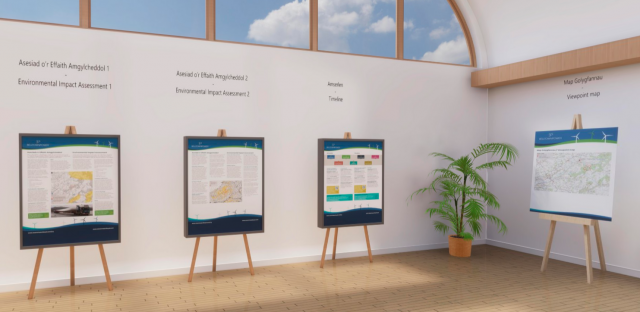
The materials from our Pre-Application Consultation public exhibitions remain available to view online here.
Public exhibitions as part of our Pre-Application Consultation took place on:
Tues 30 September 2025, 2pm-8pm
Llanddewi Brefi Village Hall, Llanddewi Brefi, Tregaron, SY25 6RX
Wed 1 October 2025, 2pm-8pm
Coronation Hall, Pumsaint, Llanwrda, SA19 8UW
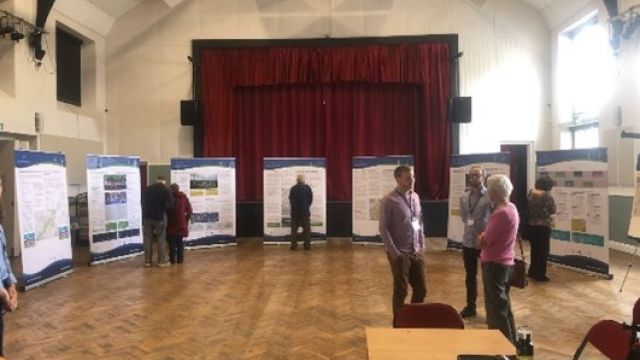
We are still happy to receive further comments on our proposals, although these will no longer form part of our formal Pre-Application Consultation process.
The feedback form to share your views with us is available here. Alternatively, contact the team:
- by email on waunmaenllwyd@belltownpower.com
- by phone on 0117 303 5217
- or send a letter to FREEPOST TC CONSULTATION (no stamp needed), or to Belltown Power, 10 Victoria Street, Bristol, BS1 6BN
DRAFT PLANNING APPLICATION DOCUMENTS
Appendix TA9.4 Ornithology and some Ornithology figures (8.5a-c, 9.9, 9.10a-b and 9.11) are confidential. These are available to relevant statutory consultees on request, please contact waunmaenllwyd@belltownpower.com.
- Waun-Maenllwyd-PAC-ES-Vol-2-Ch-1-Introduction (393.46 KB)
- Waun-Maenllwyd-PAC-ES-Vol-2-Ch-2-Location-of-Proposed-Development (235.72 KB)
- Waun-Maenllwyd-PAC-ES-Vol-2-Ch-3-Description of the Proposed Development (452.48 KB)
- Waun-Maenllwyd-PAC-ES-Vol-2-Ch-4-Reasonable Alternatives Considered (322.83 KB)
- Waun-Maenllwyd-PAC-ES-Vol-2-Ch-5-Approach-to-the-EIA (319.75 KB)
- Waun-Maenllwyd-PAC-ES-Vol-2-Ch-6-LVIA (735.56 KB)
- Waun-Maenllwyd-PAC-ES-Vol-2-Ch-7-Archaeology and Cultural Heritage (604.88 KB)
- Waun-Maenllwyd-PAC-ES-Vol-2-Ch-8-Terrestrial Ecology (1.02 MB)
- Waun-Maenllwyd-PAC-ES-Vol-2-Ch-9-Ornithology (621.68 KB)
- Waun-Maenllwyd-PAC-ES-Vol-2-Ch-10-Climate Change (325.12 KB)
- Waun-Maenllwyd-PAC-ES-Vol-2-Ch-11-Lands Soils and Water (686.46 KB)
- Waun-Maenllwyd-PAC-ES-Vol-2-Ch-12-Traffic and Transport (600.17 KB)
- Waun-Maenllwyd-PAC-ES-Vol-2-Ch-13-Noise and Vibration (345.47 KB)
- Waun-Maenllwyd-PAC-ES-Vol-2-Ch-14-Cumulative-Effects (330.35 KB)
- Waun-Maenllwyd-PAC-ES-Vol-2-Ch-15-Summary (433.03 KB)
- Waun-Maenllwyd-ES-Vol-3-TA1.1 Scoping Report_Part 1 (24.68 MB)
- Waun-Maenllwyd-ES-Vol-3-TA1.1 Scoping Report_Part 2 (24.30 MB)
- Waun-Maenllwyd-PAC-ES-Vol-3-TA1.2 Scoping Direction (8.28 MB)
- Waun-Maenllwyd-PAC-ES-Vol-3-TA1.2 Scoping Direction (8.28 MB)
- Waun-Maenllwyd-PAC-ES-Vol 3 TA3.1 Outline CEMP (1.32 MB)
- Waun-Maenllwyd-PAC-ES-Vol-3-TA3.2 Aviation Lighting and Mitigation (2.68 MB)
- Waun-Maenllwyd-PAC-ES-Vol-3-TA3.3 Arboricultural Impact Assessment (3.95 MB)
- Waun-Maenllwyd-PAC-ES-Vol-3-TA3.4 Standalone Sheet Indicative Turbine (69.01 KB)
- Waun-Maenllwyd-PAC-ES-Vol-3-TA5.1 AIL Route Survey Report (19.03 MB)
- Waun-Maenllwyd-PAC-ES-Vol-3-TA5.2 AIL Environmental Constraints Report (5.31 MB)
- Waun-Maenllwyd-PAC-ES-Vol-3-TA5.3 Aviation Report (1.45 MB)
- Waun-Maenllwyd-PAC-ES-Vol-3-TA5.4 Socio Economic Statement (496.54 KB)
- Waun-Maenllwyd-PAC-ES Vol 3 TA5.5 Shadow Flicker Impact Assessment (3.04 MB)
- Waun-Maenllwyd-PAC-ES-Vol-3-TA5.6 Telecommunications Impact Assessment (1.64 MB)
- Waun-Maenllwyd-PAC-ES-Vol-3-TA5.7 Forestry Report (3.33 MB)
- Waun-Maenllwyd-PAC-ES-Vol-3-TA6.1 LVIA Methodology (247.86 KB)
- Waun-Maenllwyd-PAC-ES-Vol-3-TA6.2 Landscape Character Assessment (297.70 KB)
- Waun-Maenllwyd-PAC-ES-Vol-3-TA6.3 Landscape Designations Assessment (211.10 KB)
- Waun-Maenllwyd-PAC-ES-Vol-3-TA6.4 Representative Viewpoints Assessment (281.52 KB)
- Waun-Maenllwyd-PAC-ES-Vol-3-TA6.5 Nightime Aviation Lighting Assessment (364.73 KB)
- Waun-Maenllwyd-PAC-ES-Vol-3-TA6.6 Residential Visual Amenity Assessement (276.81 KB)
- Waun-Maenllwyd-PAC-ES-Vol-3-TA6.6 Annex 1 RVAA Figures 1-3 (6.25 MB)
- Waun-Maenllwyd-PAC-ES-Vol-3-TA6.6 Annex 1 RVAA Figures 4-12a (8.10 MB)
- WM-PAC-ES-Vol-3-TA6.6 Annex 1 RVAA -Wirelines (2.18 MB)
- Waun-Maenllwyd-PAC-ES-Vol-3-TA6.7 Graphics and Visual Aids Methodology (178.01 KB)
- Waun-Maenllwyd-PAC-ES-Vol-3-TA7.1 Cultural Heritage Appraisal (5.24 MB)
- Waun-Maenllwyd-PAC-ES-Vol-3-TA7.2 Archaeological Desk Based Assessment (13.90 MB)
- Waun-Maenllwyd-PAC-ES-Vol-3-TA7.3 Site and Setting Surveys (5.77 MB)
- Waun-Maenllwyd-PAC-ES-Vol-3-TA7.4 Gazetteer (290.43 KB)
- Waun-Maenllwyd-PAC-ES-Vol-3-TA7.5 Viewpoint 1-6 (10.11 MB)
- Waun-Maenllwyd-PAC-ES-Vol-3-TA7.5 Viewpoint 7-12 (4.89 MB)
- Waun-Maenllwyd-PAC-ES-Vol-3-TA7.6 photo viewpoint 1 (6.88 MB)
- Waun-Maenllwyd-PAC-ES-Vol-3-TA7.6 photo viewpoint 2 (7.05 MB)
- Waun-Maenllwyd-PAC-ES-Vol-3-TA7.6 photo viewpoint 4 (6.34 MB)
- Waun-Maenllwyd-PAC-ES-Vol-3-TA7.7.1 Pumsaint Fort, Archaeological Evaluations (6.81 MB)
- Waun-Maenllwyd-PAC-ES-Vol-3-TA7.7.2 Pumsaint Fort Phase II Archaeological Evaluation (4.70 MB)
- Waun-Maenllwyd-PAC-ES-Vol-3-TA8.1 Habitats and Vegetation (5.35 MB)
- Waun-Maenllwyd-PAC-ES-Vol-3-TA8.2 Protected Species (2.70 MB)
- Waun-Maenllwyd-PAC-ES-Vol-3-TA8.3 Bats (2.56 MB)
- Waun-Maenllwyd-PAC-ES-Vol-3-TA8.4 Outline Habitat Management Plan (488.71 KB)
- Waun-Maenllwyd-PAC-ES-Vol-3-TA8.5 Dormouse Assessment partial report - preliminary draft (1.84 MB)
- Waun-Maenllwyd-PAC-ES-Vol-3-TA8.6 HRA screening (496.05 KB)
- Waun-Maenllwyd-PAC-ES-Vol-3-TA8.7 Epiphytic Lichens (586.81 KB)
- Waun-Maenllwyd-PAC-ES-Vol-3-TA8.8 Bryophytes (4.28 MB)
- Waun-Maenllwyd-PAC-ES-Vol-3-TA9.1 Ornithology (1.57 MB)
- Waun-Maenllwyd-PAC-ES-Vol-3-TA9.2 Collision Risk Model (808.91 KB)
- Waun-Maenllwyd-PAC-ES-Vol-3-TA9.3 Information to Inform HRA - Ornithology (537.36 KB)
- Waun-Maenllwyd-PAC-ES-Vol-3-TA10.1 The Scottish Govs Carbon Assessment Tool (355.06 KB)
- Waun-Maenllwyd-PAC-ES-Vol-3-TA11.1 Good Practice Methods (217.26 KB)
- Waun-Maenllwyd-PAC-ES-Vol-3-TA11.2 Peat Survey Report (11.95 MB)
- Waun-Maenllwyd-PAC-ES-Vol-3-TA11.3 Outline Peat Management Plan (416.38 KB)
- Waun-Maenllwyd-PAC-ES-Vol-3-TA11.4 Peat Landslide Hazard Risk Assessment (2.64 MB)
- Waun-Maenllwyd-PAC-ES-Vol-3-TA11.4 Figures 11.4.1-11.4.5 (22.77 MB)
- Waun-Maenllwyd-PAC-ES-Vol-3-TA11.4 Figures 11.4.6-11.4.10 (21.58 MB)
- Waun-Maenllwyd-PAC-ES-Vol-3-TA11.5 Watercourse Crossings and Infrastructure within 50m (1.65 MB)
- Waun-Maenllwyd-PAC-ES-Vol-3-TA11.6 GWDTE assessment (538.40 KB)
- Waun-Maenllwyd-PAC-ES-Vol-3-TA11.7 Borrow Pit Assessment (3.41 MB)
- Waun-Maenllwyd-PAC-ES-Vol-3-TA11.8 Outline Soils Management Plan (611.94 KB)
- Waun-Maenllwyd-PAC-ES-Vol-3-TA12.1-Transport Assessment (28.37 MB)
- Waun-Maenllwyd-PAC-ES-Vol-3-TA13.1 Environmental noise assessment (2.08 MB)
- Waun-Maenllwyd-PAC-ES-Vol-3-TA14.1 Long List of Approved Committed Developments (462.74 KB)
- Waun-Maenllwyd-PAC-ES-Vol-4-Chapter-1-Figures (9.36 MB)
- Waun-Maenllwyd-PAC-ES-Vol-4-Chapter-2-Figures (18.45 MB)
- Waun-Maenllwyd-PAC-ES-Vol-4-Chapter-3-Figures (8.67 MB)
- Waun-Maenllwyd-PAC-ES-Vol-4-Chapter-4-Figures (27.85 MB)
- Waun-Maenllwyd-PAC-ES-Vol 4 Fig 6.1 Topography and Landcover A1 (9.42 MB)
- Waun-Maenllwyd-PAC-ES-Vol 4 Fig 6.2 Blade Tip ZTV Bare Ground (8.42 MB)
- Waun-Maenllwyd-PAC-ES-Vol 4 Fig 6.3 Hub Height ZTV Bare Ground (8.32 MB)
- Waun-Maenllwyd-PAC-ES-Vol 4 Fig 6.4 Blade Tip ZTV with Screening A1 (9.24 MB)
- Waun-Maenllwyd-PAC-ES-Vol 4 Fig 6.5 Hub Height ZTV with Screening A1 (9.10 MB)
- Waun-Maenllwyd-PAC-ES-Vol 4 Fig 6.6 Landscape Character with Blade Tip ZTV Screening A1 (9.56 MB)
- Waun-Maenllwyd-PAC-ES-Vol 4 Fig 6.7 Landscape Designations with Blade Tip ZTV with Screening A1 (9.37 MB)
- Waun-Maenllwyd-PAC-ES-Vol 4 Fig 6.8 Recreational Routes with Blade Tip ZTV with Screening A1 (10.04 MB)
- Waun-Maenllwyd-PAC-ES-Vol 4 Fig 6.9 Cumulative Development Location Plan A1 (9.16 MB)
- Waun-Maenllwyd-PAC-ES-Vol 4 Fig 6.10 Landscape Character with Cumulative Devel A1 (7.65 MB)
- Waun-Maenllwyd-PAC-ES-Vol 4 Fig 6.11 Cumulative ZTV - with Screening Proposed Development and Operational Schemes (5.34 MB)
- Waun-Maenllwyd-PAC-ES-Vol 4 Fig 6.12 Cumulative ZTV - with Screening Proposed Development and Consented Schemes (5.27 MB)
- Waun-Maenllwyd-PAC-ES-Vol 4 Fig 6.13 Cumulative ZTV - with Screening Proposed Development and Planning Schemes (5.30 MB)
- Waun-Maenllwyd-PAC-ES-Vol 4 Fig 6.14 Cumulative ZTV - with Screening Proposed Development and PAC Schemes (5.28 MB)
- Waun-Maenllwyd-PAC-ES-Vol 4 Fig 6.15 Aviation Lighting Intensity ZTV (5.38 MB)
- Waun-Maenllwyd-PAC-ES-Vol 4 Fig 6.16 Landscape Designations and Existing Light Environment (4.33 MB)
- Waun-Maenllwyd-PAC-ES-Vol-4-Chapter-7-Figures (5.79 MB)
- Waun-Maenllwyd-PAC-ES-Vol-4-Chapter-8-Figure 8.1a-b (20.73 MB)
- Waun-Maenllwyd-PAC-ES-Vol-4-Chapter-8-Figure 8.1c-e (21.36 MB)
- Waun-Maenllwyd-PAC-ES-Vol-4-Chapter-8-Figure 8.2a-b (5.09 MB)
- Waun-Maenllwyd-PAC-ES-Vol-4-Chapter-8-Figure 8.3 and 8.4 (3.35 MB)
- Waun-Maenllwyd-PAC-ES-Vol-4-Chapter-8-Figure 8.6 (2.10 MB)
- Waun-Maenllwyd-PAC-ES-Vol-4-Chapter-8-Figure 8.7a (1.65 MB)
- Waun-Maenllwyd-PAC-ES-Vol-4-Chapter-8-Figure 8.7b pages 1-5 (21.40 MB)
- Waun-Maenllwyd-PAC-ES-Vol-4-Chapter-8-Figure 8.7b pages 6-11 (27.31 MB)
- Waun-Maenllwyd-PAC-ES-Vol-4-Chapter-8-Figure 8.7c (4.29 MB)
- Waun-Maenllwyd-PAC-ES-Vol-4-Chapter-8-Figure 8.8 (1.74 MB)
- Waun-Maenllwyd-PAC-ES-Vol-4-Chapter-8-Figure 8.9 (1.83 MB)
- Waun-Maenllwyd-PAC-ES-Vol-4-Chapter-9-Figure 9.1 and 9.2a-c (8.53 MB)
- Waun-Maenllwyd-PAC-ES-Vol-4-Chapter-9-Figure 9.3 and 9.4a-b (5.95 MB)
- Waun-Maenllwyd-PAC-ES-Vol-4-Chapter-9-Figure 9.5 and 9.6a-b (5.52 MB)
- Waun-Maenllwyd-PAC-ES-Vol-4-Chapter-9-Figure 9.7a-b and 9.8 (6.08 MB)
- Waun-Maenllwyd-PAC-ES-Vol 4 Fig 11_1 Hydrological Setting (8.61 MB)
- Waun-Maenllwyd-PAC-ES-Vol 4 Fig 11_2_a_c National Soil Map (10.05 MB)
- Waun-Maenllwyd-PAC-ES-Vol-4 Fig 11_3_a_c Peatlands of Wales Evidence Map (9.74 MB)
- Waun-Maenllwyd-PAC-ES-Vol-4 Fig 11_4_a_c Superficial Geology (9.72 MB)
- Waun-Maenllwyd-PAC-ES-Vol-4 Fig 11_5_a_c Bedrock Geology (6.32 MB)
- Waun-Maenllwyd-PAC-ES-Vol 4 Fig 11_6_a_e Hydrological Features (7.63 MB)
- Waun-Maenllwyd-PAC-ES-Vol 4 Fig 11_7_a_c Hydrogeological Regime (9.61 MB)
- Waun Maenllwyd-PAC-ES-Vol 4 Fig 11_8_a_c Potential GWDTEs (7.49 MB)
- Waun-Maenllwyd-PAC-ES-Vol 4 Fig 11_9_a_c Depth of Penetration and Probing Location (9.80 MB)
- Waun-Maenllwyd-PAC-ES-Vol 4 Fig 11_10_a_c Estimated Peat Depth (9.93 MB)
- Waun-Maenllwyd-PAC-ES-Vol 4 Fig 11_11 Peat Reuse and Restoration (5.97 MB)
- Waun-Maenllwyd-PAC-ES-Vol-4-Chapter-12-Figures (21.52 MB)
- Waun-Maenllwyd-PAC-ES-Vol-4-Chapter-13-Figures (3.34 MB)
- Waun-Maenllwyd-PAC-ES-Vol-4-Chapter-14-Figures (6.21 MB)
- Waun-Maenllwyd-PAC-ES-Vol 3 TA6.8 VP01 (6.62 MB)
- Waun-Maenllwyd-PAC-ES-Vol 3 TA6.8 VP02 (8.07 MB)
- Waun-Maenllwyd-PAC-ES-Vol 3 TA6.8 VP03 (8.22 MB)
- Waun-Maenllwyd-PAC-ES-Vol 3 TA6.8 VP04 (6.64 MB)
- Waun-Maenllwyd-PAC-ES-Vol 3 TA6.8 VP05 (5.04 MB)
- Waun-Maenllwyd-PAC-ES-Vol 3 TA6.8 VP06 (8.16 MB)
- Waun-Maenllwyd-PAC-ES-Vol 3 TA6.8 VP07 (6.49 MB)
- Waun-Maenllwyd-PAC-ES-Vol 3 TA6.8 VP08 (7.84 MB)
- Waun-Maenllwyd-PAC-ES-Vol 3 TA6.8 VP09 (5.53 MB)
- Waun-Maenllwyd-PAC-ES-Vol 3 TA6.8 VP010 (4.61 MB)
- Waun-Maenllwyd-PAC-ES-Vol 3 TA6.8 VP011 (6.20 MB)
- Waun-Maenllwyd-PAC-ES-Vol 3 TA6.8 VP012 (8.72 MB)
- Waun-Maenllwyd-PAC-ES-Vol 3 TA6.8 VP013 (6.41 MB)
- Waun-Maenllwyd-PAC-ES-Vol 3 TA6.8 VP014 (8.74 MB)
- Waun-Maenllwyd-PAC-ES-Vol 3 TA6.8 VP015 (7.73 MB)
- Waun-Maenllwyd-PAC-ES-Vol 3 TA6.8 VP016 (7.05 MB)
- Waun-Maenllwyd-PAC-ES-Vol 3 TA6.8 VP017 (9.27 MB)
- Waun-Maenllwyd-PAC-Secondary Consents Statement (242.20 KB)
- Waun-Maenllwyd-PAC-Section 16 Application Form (310.56 KB)
- Waun-Maenllwyd-PAC-Section 16 Application Plan (6.92 MB)
- Waun-Maenllwyd-PAC-Common Land Report (12.36 MB)
- Waun-Maenllywd-PAC-CL9 Common Land Map (304.83 KB)
- Waun-Maenllwyd-PAC-CL9 Common Land Register (2.84 MB)
- Waun-Maenllwyd-PAC-Application Form (490.07 KB)
- Waun-Maenllwyd-PAC-Planning Design and Access Statement (4.90 MB)
- Waun-Maenllwyd-PAC-Green Infrastructure Statement for PAC (879.67 KB)
- Waun-Maenllwyd Flood Consequences Assessment Draft for PAC (4.50 MB)
- Waun-Maenllwyd-Drainage Statement Draft for PAC (3.72 MB)
Timeline
JUN 23
First Consultation Events
SEP 23 - SEP 25
Preparation of Planning Submission
SEP – DEC 25
Pre-Application Consultation
EARLY 26
Target Planning Submission
EARLY-MID 2027
Expected Planning Determination
EARLY 2029
Target Construction Start
MID-LATE 2030
Target Commercial Operation Start Date
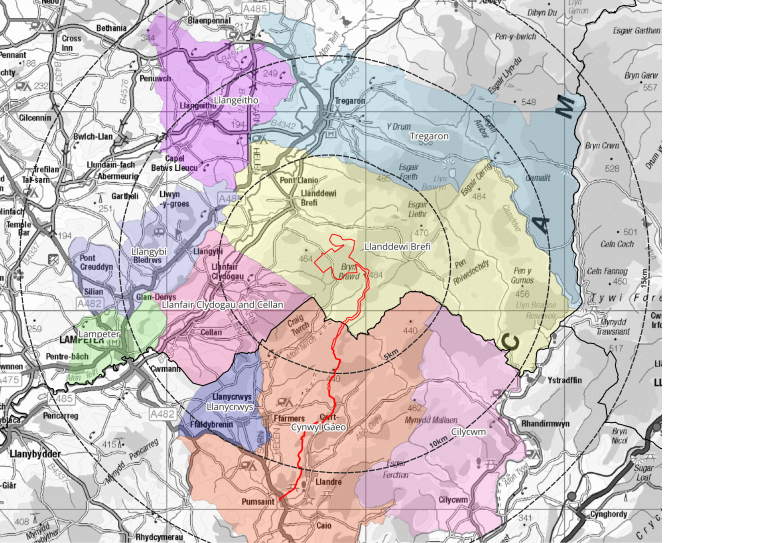
Community
At Belltown Power we fundamentally believe that renewable energy projects should benefit the communities that host them. We want to go beyond simply offering the opportunity for local investment into our projects and actually take demonstrable steps to enable the uptake of community ownership in a way that benefits everyone.
Communities local to the Waun Maenllwyd Wind Energy Hub will have the opportunity to benefit through our groundbreaking community ownership scheme.
Belltown’s Community Ownership scheme includes:
- Donating 1% of the equity in the project to the local community, and
- Enabling them to purchase a further 4% of the equity of the project at cost (significantly discounted from the market rate) once the project is operational, and potentially more at market value, if desired.
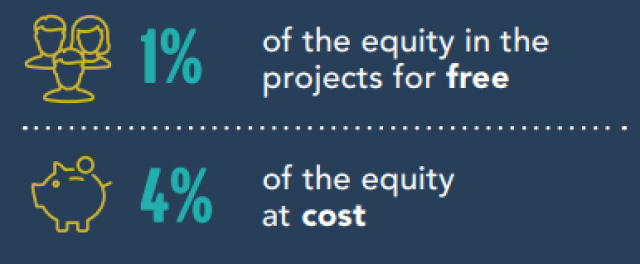
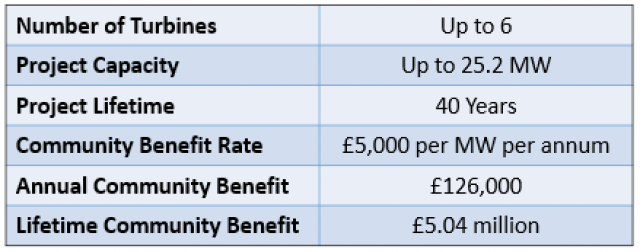
Community Benefit
In addition to this attractive ownership offering, we are committed to providing £5,000/MW per year (index linked) in Community Benefit for the lifetime of the project. In the case of Waun Maenllwyd, this represents £126,000 per year for 40 years (£5.04million Lifetime Community Benefit).
Depending on a community's need, the Benefit Funding could be part or wholly front loaded to support larger projects. For example, this flexible structure means the community benefit package could be used to:
- Buy additional ownership of Waun Maenllwyd Wind Energy Hub to achieve higher returns over the operational life, and
- Fund local initiatives with front loaded funding to allow support for larger projects
Once the site is operational, the Ownership and Community Benefit income would be received by a local community partner organisation and distributed as they see fit. Some key potential themes that emerged for its use from the first consultation include:
- Discounted energy bills
- Funding local facilities and organisations
- Improving local public services
- Support for local jobs and employment
- Supporting young people in the area
- Funding for environmental projects
To provide your feedback and ask any questions on the Community Benefit and Ownership funding, please fill out our feedback form here, or get in touch at waunmaenllwyd@belltownpower.com
Near to our Tirgwynt site in Powys, the Carno Primary School faced closure due to the condition of temporary buildings they were using. Due to our flexible community benefit offering we were able to substitute some of the annual payments with a larger, upfront payment which enabled the construction of a new school building, allowing the local school to continue to serve the community for future generations.
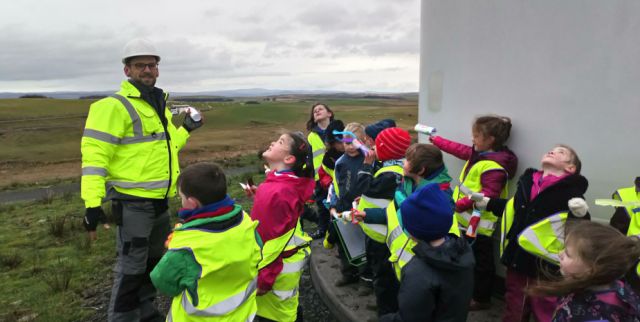
We will continue to work closely with the local Community Councils throughout the planning process to develop our Community Offering. A Community Offering Workshop in 2024 was attended by representatives from the local council areas and Belltown are working closely with Community Energy Wales to develop a shared ownership structure that best reflects the needs of the Community. More information about this will be available in a Collaborative Benefits Report which will form part of the final planning submission.
Education: Inspiring the next generation
We believe passionately in education and have been running the Belltown Education Programme since 2015 with the aim of inspiring the next generation of engineers and scientists who will tackle the climate emergency. This programme already supports 15 schools local to our sites and we intend to continue to expand this to all new projects that we are developing, including Waun Maenllwyd.
Opportunities for Local businesses and Suppliers
Belltown Power is committed to providing material benefit to the communities that host them. To ensure this happens, we will use local supply chain where they meet the project’s HSEQ (Health, Safety, Environment and Quality) requirements and where they are within 10% of the best quote tendered.
There are a wide range of services and suppliers required to build and operate a wind farm, including but not limited to:
- Construction, drainage and fencing contractors,
- Materials suppliers and building merchants,
- Plant hire and security,
- Fuel providers and waste management, and
- Local hospitality providers and car hire.
To understand the full range of opportunities available please get in touch via our registration form.
Meet the Buyer
Through our public consultation exhibitions and engagement with Chambers Wales and regional business representatives we aim to identify and engage with local companies and supply chain who may be interested in getting involved in this scheme.
In due course, we will be holding “Meet the Buyer” events where you can meet the project team, we can learn more about your business and we can discuss opportunities to work together. If you would like to know more we would love to hear from you. All you need to do fill in our registration form or leave a message at waunmaenllwyd@belltownpower.com and one of our team will be in contact to collect further details and answer any questions.

1. WMO, Weather-related disasters (2021)
2. Statista, Historic average carbon dioxide (CO2) levels, Ian Tiseo
3. RenewableUK, Statistics explained, figures based on a 25.2MW wind energy hub
4. Welsh Government, StatsWales, Households by Local Authority and Year, September 2021
Frequently Asked Questions
The Project and Planning Process
We are proposing up to six turbines, that will have the capacity to generate 25.2MW. This is enough to power the equivalent of 28,500 homes each year.
Following feedback from the first consultation and scoping consultees we have revised the layout:
- We have worked closely with our landscape architects to minimise the visual impact of the scheme
- We have reduced all tip heights, from 230m to 200m for 5 turbines and 180m for 1 turbine
The site sits within one of the Welsh Government’s Pre-Assessed Areas, which has been identified as an area capable of accommodating large-scale onshore wind development from a landscape perspective, as well as having a suitable wind resource which lends itself to development of this type.
The Welsh Government has set a target for Wales to generate 100% of the electricity it consumes from renewable sources by 2035. To meet this ambition, we need additional onshore wind, as well offshore wind, solar PV, energy storage, hydrogen and electric vehicles, together with energy efficiency. To tackle the Climate Emergency that Wales and other UK and international governments have declared, we must make progress during the 2020s. Onshore wind is the fastest and most easily deployable renewable energy that we have at our disposal now and therefore we feel that the Waun Maenllwyd Energy Hub can help to play a part in meeting these goals, reducing the UK’s dependency on foreign energy sources and ensure a greater level of stability in energy prices in the longer term. Unfortunately offshore wind is more expensive and takes significantly longer to develop, consent and construct.
The project will connect to the local grid network via a 33kV overhead line running to Lampeter. The cable will be supported on wooden poles, like those already in the area. We have no proposals to erect large pylons as part of this project. The exact connection route will be designed by National Grid over the next few years and will be subject to its own planning application process, including public consultations.
Belltown has no plans to expand the proposed Waun Maenllwyd site beyond the scheme currently proposed, and no plans for other projects in the area. Like Waun Maenllwyd, every project that is proposed by any developer will undergo a rigorous planning application process and is ultimately assessed on its own merits by Planning and Environment Decisions Wales (PEDW), who will subsequently make a recommendation to the Welsh Ministers as to whether to grant planning permission or not.
As the project will deliver in excess of 10MW of wind energy, it will constitute a Development of National Significance (DNS) under the Planning (Wales) Act 2015 and Belltown Power must apply to Planning and Environment Decisions Wales (PEDW, formerly the Planning Inspectorate Wales), which will make a recommendation to Welsh Ministers on whether planning permission should be granted.
Ultimately, Welsh Ministers will decide whether or not to approve the application, however many other parties will have the opportunity to influence the proposals, including the host local authorities, Ceredigion and Carmarthenshire County Councils, as well as local communities and interested parties.
The Pre-Application Consultation period is now open, running from 17 September - 4 December 2025. This is the last consultation before we submit the planning application to PEDW later this year.
We are committed to engaging openly and honestly, in as accessible and inclusive a way as possible and would therefore encourage anyone who is interested in learning more about the project or providing their views to get in touch. The best way to do this is via email to waunmaenllwyd@belltownpower.com or to fill out a feedback form here.
Once PEDW accept the application they will publish it on their web portal and advertise a representation period of no less than 5 weeks, during which anyone can comment on the application directly to PEDW.
Our proposed timeline is available on our website here.
We are aiming to submit our proposals to Planning and Environment Decisions Wales (PEDW) in early 2026. PEDW will then review our planning application and make a recommendation to Welsh Ministers, who will decide whether or not to grant planning consent. The construction timeline depends on when a final decision on whether to grant planning permission is made, which can take 12 months or longer. There may also be further conditions that we have to meet as part of the planning process. We hope to begin construction in early 2029, and begin commercial operation in mid-late 2030.
If consented, Waun Maenllwyd Wind Energy Hub would be in place for 40 years after construction. At the end of its life, the site may be repowered and continue to generate energy, or the turbines will be fully decommissioned and removed from the area.
In order for the site to be repowered, a further planning application would need to be submitted, considered and consented.
It is hard to know what the best practice will be for decommissioning that far in the future, but every effort will be made to recycle or re-use components before anything is sent to landfill. The UK is committed to developing at least one specialist wind turbine blade recycling/re-use facility by 2030, and the industry is actively moving towards a circular economy model through the work of the Coalition for Wind Industry Circularity.
In addition to working with local councils to ensure that the decommissioning process is as smooth as possible, a financial fund will also be put aside for decommissioning so that, in the unlikely event that Belltown was to go in bankruptcy, the windfarm would still be decommissioned safely. This decommissioning fund will be calculated by an independent surveyor and agreed with the Council.
Belltown Power UK is a British owned company with headquarters in Bristol. Profits from the scheme will be distributed to our shareholders and employees.
Belltown wants to enable local ownership of the projects we develop. One per cent of the Waun Maenllwyd project is available for free, a further 4% at cost (discounted from market price), and further equity will be available at market price if there is appetite in the area. The remainder of the developed project is owned by the Joint Venture Belltown have with investment partner Foresight Group.
Wales is currently a net exporter of energy: in 2022, 29 Terrawatt-hours (TWh)* of electricity was generated in Wales, less than half of which (13TWh) was consumed in the country. However, over three quarters of this energy was produced from non-renewable sources, primarily gas.[1] To meet the Welsh Government's target for Net Zero greenhouse gas emissions by 2050, this fossil fuel power needs to be replaced with renewable generation.
The switch from fossil fuels to renewable electricity, which is happening now in sectors such as heating (air or ground-source heat pumps) and transport (electric vehicles), is also expected to result in Wales’ electricity consumption doubling by 2050.[2]
Overall, to reach Net Zero by 2050 and supply enough electricity to meet growing demand, total renewable energy deployment in Wales needs to almost double from 3.5 Gigawatts (GW)** in 2021 to 6.6GW by 2030, and then triple again to 18.2GW by 2050.[3] This isn’t taking into account that much of the existing wind generation in Wales will reach the end of its operational life in this time period, so also needs to be replaced with new renewable energy generation.
Much of Wales’ required renewable capacity can be built as offshore windfarms in the Celtic Sea, which has been assessed as potentially being able to accommodate up to 24GW by 2045.[4] However, the rising prices of turbine components and manufacture is squeezing the economic viability of offshore wind: at the latest Contracts for Difference auction in Autumn 2023, where government support is offered through a fixed price for energy, no offshore projects entered bids as the fixed price was simply too low to allow projects to be economically viable.[5] The strike price for offshore wind has now been raised by 66% for the next round of auctions this year.[6] Onshore wind projects, which cost around half as much to deploy, were much more successful and can be deployed in much shorter timeframes, therefore contributing towards the 2030 renewable capacity needed to stay on course for Net Zero, as well as generating the cheapest form of electricity in the UK.
With this in mind, Renewables UK, an industry body, has calculated that onshore wind capacity in Wales needs to increase to 3.5GW by 2030 in order to meet our Net Zero targets,[7] from 1.3GW in 2022.[8] This is equivalent to approximately 300 additional modern onshore wind turbines. Planning applications for Developments of National Significance (DNS) are currently in progress include around 320 turbines,[9] although a lot of these are at early stages and not all will get planning consent.
*TWh = Terrawatt hours, a unit of measurement for energy. An average home uses 2700 kWh (kilowatt hours) of electricity each year, which equates to 2.7 Megawatt-hours (MWh) or 0.0000027 Terrawatt-hours.
** GW = Gigawatts, a measure of power, or the amount of energy that is used or supplied to the grid at any given moment. A GW is 1 billion watts.
This website provides a good explanation of the difference between energy (kWh) and power (kW) - What Is A Kilowatt-Hour (kWh) & What Can 1 kWh Power? | USE (utilitysavingexpert.com)
[1] Energy Generation in Wales: 2022 (gov.wales) p.3
[2] Energy Generation in Wales: 2022 (gov.wales) p.7
[3] Energy Systems Catapult, 2023. Future Energy Grids for Wales (FEW) – Insights Report. Issue 1.1, p.3 Accessible on Future Energy Grids for Wales - Energy Systems Catapult
[4] ORE Catapult Launches First Floater Supply Chain Development Scheme in Wales | Offshore Wind
[5] No Bidders in British Offshore Wind Auction - The New York Times (nytimes.com)
[6] AR6 core parameters published | Contracts for difference CfD (cfdallocationround.uk)
[7]https://cdn.ymaws.com/www.renewableuk.com/resource/resmgr/media/onshore_wind_prospectus_fina.pdf p.38
[8] Energy Generation in Wales: 2022 (gov.wales) p.6
[9] Search for a case - Planning Casework (gov.wales) – accessed 4/3/24
Wind and solar generate electricity intermittently, when the wind is blowing and the sun is shining. To ensure electricity is available when it is needed, there are many options available for storing it in the national grid.
Large-scale battery storage technology is now readily available and being deployed. At UK level, National Grid Scenarios modelling suggests we need to connect 22-32 Gigawatts (GW)* of battery storage to the grid by 2050,[1] but that deployment is moving quickly, with 18GW already expected to connect to the system by 2028.[2]
Around 35% of these batteries will likely be in Scotland, and a variety of technologies are under development alongside the standard lithium-ion battery, including compressed air, gravity and flow battery technology.[3] In Wales, there were four operating commercial scale battery sites as of 2022 with a combined total power capacity of 27 Megawatts (MW),[4] but a further 750MW of battery storage sites have planning permission, and projects totalling another 650MW have submitted planning applications.[5]
Besides batteries, electricity can be stored using pumped hydro storage or thermal storage solutions, and the Welsh Government is also supporting development of electricity storage using hydrogen.[6] Consumer behaviour (or ‘demand side response’) will also play a critical role by reducing demand on the grid at any one time and therefore reducing the overall storage capacity needed. This is through households and businesses adapting to increase energy efficiency (for example through smart heating and building insulation) and managing their electricity use over the day (for example by using white goods and charging electric vehicles overnight).
Using a combination of batteries, existing pumped hydro storage, hydrogen and demand side response, modelling commissioned by the Welsh Government suggests that, depending on future decisions made regarding Wales’ energy system, there may not be a need for any additional pumped hydro storage and associated reservoirs to reach Net Zero by 2050.[7]
*GW = Gigawatts, a unit of power capacity, or the amount of energy available at any given instant. 1 GW = 1000 Megawatts (MW).
The MW rating of a battery is the amount of power available when it is fully charged. Batteries also have a MWh (Megawatt-hour) duration, which says how long the battery could discharge its full power capacity for. For example, a 1MW battery with a 1.5MWh duration could discharge 1MW of power for 1.5hours.
[1] download (nationalgrideso.com) p.194, Fig FL11
[2] download (nationalgrideso.com) p.146
[3] What is battery storage? | National Grid Group
[4] Energy Generation in Wales: 2022 (gov.wales) p.39
[5] Renewable Energy Planning Database, Jan 2024, downloaded 4/3/24. Renewable Energy Planning Database: quarterly extract - GOV.UK (www.gov.uk)
[6] Energy Systems Catapult, 2023. Future Energy Grids for Wales (FEW) – Insights Report. Issue 1.1, Accessible on Future Energy Grids for Wales - Energy Systems Catapult
[7] Energy Systems Catapult, 2023. Future Energy Grids for Wales (FEW) – Insights Report. Issue 1.1, p.14 Accessible on Future Energy Grids for Wales - Energy Systems Catapult
Local People and Economy
At Belltown Power we fundamentally believe that renewable energy projects should benefit the communities that host them, and we are proposing two separate offerings to realise this.
Firstly, we guarantee £5,000 (index-linked) per year of community benefit funding for every MW of capacity. Waun Maenllwyd has a grid capacity of 25.2MW, which equates to around £126,000 every year index linked, or around £5 million over the 40-year lifetime of the project. We look to work with the local communities to identify community benefit initiatives that can have a meaningful impact and legacy, whether that is through the Community Benefit Fund, local electricity discounts, education, local businesses or enhancing the local environment.
We are working closely with relevant local councils, stakeholders, community groups and others to identify areas or issues which could be addressed through the proposed community benefit fund. While we expect the majority of the funding will be focused on the area around Llanddewi Brefi as the site’s host community, we are keen to hear views on how best to apportion shares to neighbouring communities as well.
Secondly, we are also committed to giving 1% of the project ownership to local communities for free and offering a further 4% ownership at cost (discounted from market value). Further ownership will be available at market value if there is appetite from the local community. Again, we are discussing this offer with local councils and stakeholders in the coming weeks and months to understand the level of interest in this offer as well as the best way for communities to make the most of this.
As part of our plans for Waun Maenllwyd Energy Hub we will be establishing a Community Benefit Fund which will help to support projects and tackle issues in local communities around the site. Further details about this fund will be confirmed as we progress through the planning stages of the project, however, we would be keen to speak with anyone with an interest or experience in operating Community Benefit Funds or similar initiatives in the area through the early consultation process.
Our draft socio-economic statement calculates that the project would support over 180 jobs in the UK over the project construction period. Our proposals will generate a significant boost to the local economy. To ensure that we generate the maximum economic impact in the areas surrounding the site, we will be looking to build up a network of local suppliers to take forward into the procurement stage, should we receive planning consent. Of equal importance to us will be working with a wide range of stakeholders to identify how the project can support jobs and training opportunities directly as well as through the wider supply chain, demonstrating our commitment to the local and regional economy.
We encourage local businesses and suppliers to get in touch with us or to register as a local business through our feedback form.
Our specialist transport engineers have undertaken several detailed assessments of the possible routes to reach site. Travelling north along the Talley road then turning off at Pumsaint and travelling along existing and new forestry track to reach the site from the south is the least disruptive route to take given the length of the proposed turbine blades and tower sections. Prioritising this southern route will also help to minimise the amount of construction traffic along the rural roads around Llanddewi Brefi.
Nonetheless, we fully appreciate that, for a limited time during construction, we will be adding more traffic to the existing logging lorries in the local area. During deliveries, we will operate a text alert service for local residents to inform them of each turbine delivery as it is confirmed with Dyfed-Powys Police so they can plan their day accordingly. During operation, traffic associated with the wind farm will be limited to one or two small maintenance vehicles once a month or so.
We understand there is concern about the visual impact of the site and the size of the turbines. One of the reasons this site was chosen is because it is in one of the Welsh Government’s Pre-Assessed Areas (PAA), which the government has identified as part of the Future Wales National Development Framework as areas capable of accommodating large-scale onshore wind turbines from a landscape perspective.
Being part of a PAA doesn’t change the need for a detailed assessment of the site’s impacts, which is included in our draft planning application documents. Following consultation with NRW, 17 viewpoints have been selected for assessment, including three which have also been considered for their night-time views.
Turbine tip heights have been reduced from 230m to 200m (five turbines) and 180m (one turbine) in response to consultee and public feedback at the last consultation, to improve the visual impact from key public and residential receptors. The height of the turbines we are proposing is determined largely by market forces. Since the removal of subsidies in 2017, manufacturers have had to focus on larger turbines in order to make onshore wind financially viable again. As a result, they are phasing out manufacture of smaller turbines and so current site development needs to ensure that the turbines proposed will be available at the time sites could start construction. This has fed into the turbine sizing proposed on Waun Maenllwyd.
As the proposed turbines are taller than 150m to tip it is a requirement for some of them to be lit for aviation safety. Three of the six turbines – Turbines 1, 3 and 5 - would have red lights at the top of the towers, with very narrow (3 degrees) beams to minimise downwards or upwards spill. Most of the time when visibility is good, they would be reduced to 10% of their output
There is no clear consensus among academic studies about the impact of turbines on property prices. Although a 2014 study suggested that house prices could grow up to 5-6% more slowly if they were within 4km of turbines, the methodology used was somewhat simplistic, so the results aren’t completely reliable. The study assumed turbine visibility is the key driver for impact to house prices, but didn’t account for buildings or other structures obstructing turbine views so not all the properties considered had views of turbines. It also analysed data on a postcode level only, effectively assuming that all properties within a postcode are interchangeable.
A more recent study in Scotland found that there was no effect on house prices within a 4km radius of turbines, and there was in fact a slight benefit to house prices where turbines were visible 4-5km away. This study updated and refined the methodology used in 2014. In our layout design, we have ensured that Waun Maenllwyd turbines are sited as sensitively as possible to minimise views of turbines in the local area.
Waun Maenllywd and the Environment
As part of our Environmental Impact Assessment, we have undertaken detailed bird and ecology surveys across the site and the immediate area over the last two years, which directly informed the location and type of turbines we are proposing for the scheme. The findings of these surveys as assessments are detailed in our draft Environmental Statement (ES), which is available now for people to review and comment on as part of the Pre-Application Consultation.
In our revised design, we have not placed turbines or infrastructure where key habitats are identified, or in areas where collision risk modelling suggests there would be an unacceptable risk for the bird species studied. If planning consent is granted, an Environmental Clerk of Works (ECoW) would be on site during construction and, should any sensitive species be encountered, the ECoW will advise appropriate buffers from work fronts to avoid disturbance.We will additionally commit to a habitat management plan which ensures an increase in key habitat areas as part of the development. An outline Habitat Management Plan is available in the draft application documents.
We have also been undertaking detailed peat surveys which has shown there to be almost no good quality peatland habitat on site, which is to be expected due to the dewatering effects of commercial forestry. Turbines and infrastructure have been carefully sited, using this survey data, to minimise any peat disturbance and avoid any good quality peatland habitat. As such, we are confident we have designed a site that has no significant impact on blanket bog.
The planning application includes a detailed assessment of the net carbon impact of the development using robust government methodologies, including consideration of the carbon emissions from the manufacturing, transport, construction and decommissioning of the turbines and site infrastructure, as well as loss of carbon sequestration potential from any tree felling and peat disturbance. Generally, these assessments show the carbon emissions from manufacturing, transport, construction, decommissioning, and loss of carbon sequestration are paid back by the carbon saving from replacing fossil-fuel power generation in approximately 1-2 years of the windfarm operating, and this site is the same at 1.6 years. These assessments also show, for UK wind farms, that the carbon savings over their operational life are many orders of magnitude higher than even the most pristine blanket bog.
As part of the Environmental Impact Assessment, our specialist consultants have carefully considered the potential impact of both noise and shadow flicker. After measuring background noise data in the area, they can accurately model the turbine conditions and any effects that may result. The primary mitigation for noise and shadow flicker is ensuring the turbines are not placed too close to residential properties, which we seek to ensure through our careful site selection process as well as refinements to design in response to engagement with statutory bodies and wider public consultation and engagement. If required however, mitigation can also be put in place to reduce the impacts, including turning turbines off for a limited time in certain conditions to ensure no unacceptable noise or shadow flicker impacts. Detailed noise and shadow flicker assessments are included in our draft ES above, so that local residents can see and understand what we are planning to minimise the impact of these issues.
In short, no. Infrasound is a term generally used to describe sounds waves with a frequency of less than 20 hertz (Hz), which is outside normal human hearing. Wind turbines can create some infrasound, but no more so than many manmade sources like traffic, trains, bridges and machinery, and natural sources including thunder, waves and the wind itself.
A recent review of 69 academic studies published since 2017 regarding infrasound and wind turbines[1] concluded that infrasound has not been shown to increase annoyance or sleep disturbance above that experienced from audible sound (for example audible wind turbine noise). The study concluded that annoyance increased as audible sound level (decibels) increased. There were also no confirmed links between infrasound and physical responses such as heart rate, metabolic effects (diabetes) and mental health.
These conclusions were further confirmed in October 2023 when the UK Government commissioned a report evaluating the need to revise current noise guidance for wind turbines.[2] The report screened hundreds of studies and reviewed in detail over 130 highly relevant independent scientific publications. It also surveyed 204 UK health and planning departments, 26 government and professional bodies, and one civic group. It concluded that (bold emphasis added):
“It has been demonstrated in controlled experiments, including the involvement of participants self-reporting to be sensitive to wind turbine infrasound, that exposure to infrasound at levels representative of wind turbine immissions* at dwellings is not associated with physiological or psychological health effects, whereas the expectation of effects from being exposed to wind turbine infrasound, and positive or negative messages influencing that expectation, can affect health symptom reporting. Overall, the findings from the existing evidence base indicate that infrasound from wind turbines at typical exposure levels has no direct adverse effects on physical or mental health, and reported symptoms of ill-health are more likely to be psychogenic in origin”.[3]
Notable conclusions from a number of these controlled experiments were that:
“exposure to either real or sham infrasound had no influence on the reporting of health symptoms by participants. However, the expectation of effects connected with the participants' attitudes prior to the experiment did have a significant effect, which supports a nocebo explanation for reported health symptoms associated with wind turbine infrasound”;[4]
“a significant influence of positive or negative media messaging on health symptom reporting has been observed. Other results also highlight that expectancy of negative effects of wind turbine infrasound exposure is associated with symptom reporting, but actual controlled exposure to infrasound is not. The review of evidence on low frequency sound and infrasound noted that emission levels from wind turbines are as low or lower than other common environmental sources such as road traffic”, and;
“Nocebo effects relating to wind turbine infrasound have been demonstrated, and it has also been shown that positive information about wind turbines and explanation of the nocebo effect itself can help to overcome this.”[5]
*’Immissions’ describes the concentration of sound/infrasound in the air in a given location. An ‘emission’ is the act of releasing that sound into the air, in this case from wind turbines and other sources of infrasound.
[1] Health Effects Related to Wind Turbine Sound: An Update - PubMed (nih.gov)
[2] Report for BEIS: A review of noise guidance for onshore wind turbines | WSP
[3] Report for BEIS, p.114
[4] Report for BEIS, p.285
[5] Report for BEIS, p.290
To reduce potential for pollution, appropriate setbacks are maintained from all watercourses on site. Additionally, as part of the Environmental Impact Assessment, private water supplies in the area have been assessed to avoid any possible run-off pollution. Good practice mitigation measures will also be put in place throughout the site construction and operation to ensure there is no run-off into watercourses or the environment.
BisPhenol A (BPA) is an organic chemical compound that is used to make many plastics and everyday products. It has become a widely used material including in the lining of food tins and glass jar lids, food and drinks containers, clothing, dental materials and medical devices, and the inside of pipes used to deliver drinking water, meaning human exposure is common.[1]
However, in high enough quantities, BPA can cause health issues by mimicking oestrogen in the body, meaning it affects hormone system functions, can damage the reproductive system and immune system, and affect cancer progression.[2] In 2023, the EU re-evaluated the data on BPA health impacts and revised the recommended tolerable daily intake (TDI) down to 0.2 nanograms per kg of body weight, 20,000 times lower than the previous TDI.[3]
BPA is a key component of epoxy resin, which is one of the materials used to make wind turbine blades and some turbine blade gelcoats. Some recent publications have sparked debate by suggesting that wind turbines could create relatively high levels of BPA pollution over their lifetimes (see 'The Turbine Group' below).
However, the chemical processes involved in strengthening and hardening the blade structure and epoxy gelcoats means that BPA molecules undergo chemical and structural change in the blade manufacturing process (see 'Manufacturing Turbine Blades' below). The blade is also covered with several layers of different gels and paints, often including a thick coat of gel along the front edge to protect it from erosion, which typically isn’t epoxy based (for more details, see our separate FAQ below). Cured (hardened) epoxy resin can break down when exposed to both water and heat together, which can release a small amount of BPA molecules.[4] However, the blade structure or epoxy-based gelcoats could only be exposed if the paint and protective layer on the blade were significantly eroded, and even if that happened it is unlikely that the Welsh weather and climate would offer the warm, wet conditions to encourage the epoxy to break down.
Operators want to maximise energy generation in order to maximise the return on their investment and so they carry out regular inspections of the blades to check for and repair any erosion to ensure the turbines operate as efficiently as possible, so significant erosion that might expose any remaining BPA molecules or cured epoxy that could break down is very uncommon. As an example, of their more than 3,500 onshore turbine blades SSE Renewables (the largest operator of onshore wind in the UK) only saw 21 instances of any internal epoxy-resin structure being exposed in 2021 – less than 0.6% of blades – and these were repaired very quickly to ensure maximum generation.[5]Even then, it’s unlikely any residual BPA was eroded from the blades given the very small amounts that could be present.
In the unlikely event that any residual, unreacted or broken-down BPA from epoxy resin in turbine blades should escape, it would biodegrade quickly. The half-life of BPA – the amount of time it takes to break down - is around 4.5 days in water and soil, and less than a day in air.[6]
If consented, Waun Maenllwyd Wind Energy Hub will use the most up to date turbine technology, construction and maintenance practices to ensure the appropriate standards are met throughout the project.
Manufacturing Turbine Blades
Wind turbine blades are composite structures typically made of glass-fibre reinforced epoxy resin. For comparison, imagine the rebar metal structures used to provide solidity and shape to concrete when constructing buildings – the glass fibres are like the metal structure, providing strength and shape for the epoxy resin to form around.
BPA molecules include a phenol ring, or hexagon shape, which gives the molecule a strong structure. To make epoxy resin, BPA molecules are chemically bonded together in a reaction called polymerisation to create new, longer molecules which hold their structure very well.[7]
During wind turbine blade manufacture, this liquid epoxy resin is mixed with a hardening agent and then applied to the glass fibre structure of the blade. The epoxy resin undergoes another chemical reaction with the hardening agent, chemically linking the epoxy polymers together to turn the resin from a liquid to solid and bind the glass fibre into the blade shape. If an epoxy resin gelcoat is also used, the same reaction will occur in the hardening process.[8]
In modern turbines, once the blade is formed an additional barrier called Leading Edge Protection (or LEP, which is typically made of polyurethane – see our separate FAQ here) is often applied to the front edge of the turbine blade. The impact of rain on the front edge of the blade as it rotates can make its surface less smooth, which creates drag, making it less aerodynamic and reducing the energy it can generate. The LEP layer is designed to absorb rain impacts, preventing erosion and keeping the surface smooth.
Finally, the entire surface of the blade is covered with additional gel coats and paints (for more details see our separate FAQ below) to protect it from UV degradation and also help make it more aerodynamic, further increasing energy generation.
The structural changes the BPA goes through during the chemical reactions in polymerisation and hardening means there are negligible amounts of residual BPA compound in turbine blades that could be emitted. In the unlikely event that a turbine blade were eroded enough to expose epoxy resin in either a gelcoat or the blade structure itself, it is very unlikely that the Welsh weather would be warm and wet enough to encourage it to break down, and it would be quickly repaired by the windfarm operator.
The Turbine Group
In 2021, a paper published by researchers at Strathclyde University[9] was used by a small Norwegian group calling themselves The Turbine Group (TTG) to create a document, which has since been widely circulated on the internet, suggesting that turbine blades could shed significant amounts of BisPhenol A over their lifetimes. The original Strathclyde study sought to analyse the impact of rain on a small sample of material that is often found within the internal structure of a wind turbine blade, and was carried out under conditions that reflected the rain impacts the leading edge of the tip of a wind turbine blade may experience.
TTG incorrectly applied the results of the Strathclyde study along the whole length of a turbine blade to reach inflated figures for estimated BPA emissions from turbine blades. It also overestimates given that the Strathclyde study samples had no paint topcoat or LEP, and by assuming that turbines would be operating at maximum speed during all rainfall. The Strathclyde researchers have confirmed that they 'cannot endorse the predictions’ of the TTG document and that the TTG ‘calculations need to be refined downwards quite significantly.’[10] No subsequent research has corroborated the results in TTG’s document.
[1] Human exposure to Bisphenol A in Europe — European Environment Agency (europa.eu)
[2] Human exposure to Bisphenol A in Europe — European Environment Agency (europa.eu), Potential Mechanisms of Bisphenol A (BPA) Contributing to Human Disease - PMC (nih.gov), Update on the Health Effects of Bisphenol A: Overwhelming Evidence of Harm - PMC (nih.gov)
[3] Human exposure to Bisphenol A in Europe — European Environment Agency (europa.eu)
[4] How are the BPA plastic products affecting our health? | World Economic Forum (weforum.org)
[5] Turbine Blade Deterioration (vikingenergy.co.uk)
[6] A Multimedia Assessment of the Environmental Fate of Bisphenol A: Human and Ecological Risk Assessment: An International Journal: Vol 8, No 5 (tandfonline.com)
[7] Illustrated Glossary of Organic Chemistry - Epoxy; epoxy resin (ucla.edu), (PDF) Characterization of epoxy composites reinforced with CaCO3-Al2O3-MgO-TiO2/CuO filler materials (researchgate.net)
[8] Synthesis and application of epoxy resins: A review - ScienceDirect - CHECK
[9] Rain Erosion Maps for Wind Turbines Based on Geographical Locations: A Case Study in Ireland and Britain (wind-watch.org)
[10] ACP_MicroplasticsFactSheet_March-2023.pdf (cleanpower.org)
Turbine blades have a range of different gelcoats and paints applied, to protect them from UV, rain and dust/dirt erosion and make them as aerodynamic as possible. Some of these gelcoats and paints are made from organic compounds which may be harmful if exposed in high enough quantities, but these are chemically and structurally altered during the hardening and curing processes so that negligible residual amounts ever remain in the final turbine blades.
There are two main types of protection for turbine blades[1]:
- A hard gelcoat can be applied as part of the blade manufacturing process. Turbine blades are made by applying an epoxy-based resin to glass fibre composites using a mould to create the blade shape (see our BPA FAQ here). Before this process begins, the moulds are lined with an epoxy, polyester or polyurethane-based liquid gelcoat, like lining a cake tin before baking. This gelcoat chemically bonds with the epoxy resin in the blade structure as it dries to create a hard, strong outer coating. A secondary epoxy-based gelcoat can also be applied once the blade is out of the mould.[2]
- Flexible coatings, paints or tapes can be applied manually as Leading Edge Protection once the blade has been constructed. These coatings are often made using an organic polymer called polyurethane, which is a type of non-harmful plastic polymer with sponge-like qualities, used in many household items. [3] Many final layer paints are also made using polyurethane.
The likelihood of either of these types of coatings releasing any harmful substances into the atmosphere or environment is very small.
A key component of epoxy resin is BisPhenol A (BPA). BPA is used to make many plastics and everyday products so human exposure is common,[4] however in high enough quantities, BPA can cause health issues by mimicking oestrogen in the body, meaning it affects hormone system functions, can damage the reproductive system and immune system, and affect cancer progression.[5] In turbine blades, the chemical processes involved in strengthening and hardening the blade structure and epoxy gelcoats means that BPA molecules undergo chemical and structural change in the blade manufacturing process (see our BPA FAQ above), so there are very few unreacted BPA molecules remaining.
Cured (hardened) epoxy resin can break down when exposed to both water and heat together, which can release a small amount of BPA molecules.[6] However, the blade structure or epoxy-based gelcoats could only be exposed if the paint and protective layer on the blade were significantly eroded, and even if that happened it is unlikely that the Welsh weather and climate would offer the warm, wet conditions to encourage the epoxy to break down. In the unlikely event that any residual, unreacted or broken-down BPA from epoxy resin in turbine blades should escape, it would biodegrade quickly. The half-life of BPA – the amount of time it takes to break down - is around 4.5 days in water and soil, and less than a day in air.[7]
Polyurethane is made in a chemical reaction between two molecules called a polyol and an isocyanate.[8] The isocyanate can be hazardous if not handled correctly, and the paint fumes can contain unreacted isocyanates, which is why blade manufacturers wear protective clothing and masks when applying the paints. However, once the paint has been applied and cured, the resulting polyurethane is chemically stable and doesn’t release any toxic substances.[9]
Different variations of isocyanate and polyol compounds create different types of polyurethane, which are used in many industries and household objects such as car seats, mattresses, memory foam, cushions and sofas, washing up sponges, expanding foam and insulation and some adhesives and sealants.[10] The latest research on improving leading edge protection substances is mostly focused on subtly changing the characteristics of the polyurethane used, to improve its protective qualities.[11]
While most turbine blade coatings are now made with polyurethane or epoxy as described above, some paints still contain fluoropolymers which are a type of PFAS (per- and polyfluoroalkyl substances)[12]. PFAS are a very broad group of around 4700 chemical substances, all of which contain a form of Carbon-Fluorine bond.[13] This bond is incredibly strong, so PFAS repel water, oil, heat and other substances, making them very useful for applications like paints, outdoor clothing, shower curtains, furniture, shoes and fire-fighting foam.[14] However, some PFAS chemicals can be toxic, and because the C-F bond is so strong, they all last a very long time in the environment. As a subset of PFAS, fluoropolymers are not toxic and are classified as a chemical of low concern according to European Centre for Ecotoxicology and Toxicology of Chemicals (ECETOC)[15] and following OECD guidelines.[16] They are not widely used in wind turbine blade coatings and are being phased out.[17]
[1] Dashtkar, A. et al., (2019): Rain erosion-resistant coatings for wind turbine blades: A review. Polymers and Polymer Composites 27:8, 443-475; Storm, K (2013): Surface protection and coatings for wind turbine rotor blades. Advances in Wind Turbine Blade Design and Materials, p387-412. Woodhead Publishing
[2] Herring, R., Dyer, K., Martin, F., Ward, C: The increasing importance of leading edge erosion and a review of existing protection solutions. Renewable and Sustainable Energy Reviews, Volume 115, 2019, 109382, https://doi.org/10.1016/j.rser.2019.109382.
[3] Ibid.
[4] Human exposure to Bisphenol A in Europe — European Environment Agency (europa.eu)
[5] Human exposure to Bisphenol A in Europe — European Environment Agency (europa.eu), Potential Mechanisms of Bisphenol A (BPA) Contributing to Human Disease - PMC (nih.gov), Update on the Health Effects of Bisphenol A: Overwhelming Evidence of Harm - PMC (nih.gov)
[6] How are the BPA plastic products affecting our health? | World Economic Forum (weforum.org)
[7] A Multimedia Assessment of the Environmental Fate of Bisphenol A: Human and Ecological Risk Assessment: An International Journal: Vol 8, No 5 (tandfonline.com)
[8] Polyurethane: Properties, Processing, and Applications - Matmatch
[9] Polyurethanes & Diisocyanates - Chemical Safety Facts
[10] Polyurethane: Properties, Processing, and Applications - Matmatch;
[11] Mishnaevsky, L. et al (2023): Recent developments in the protection of wind turbine blades against leading edge erosion: Materials solutions and predictive modelling. Renewable Energy, Volume 215, 118966.https://doi.org/10.1016/j.renene.2023.118966; see also Dashtkar et al., (2022): Graphene/sol–gel modified polyurethane coating for wind turbine blade leading edge protection: Properties and performance
[12] *Per- and Polyfluoroalkyl Substances and Alternatives in Coatings, Paints and Varnishes (CPVs) (oecd.org) p18
[13] OECD (2021), Draft 22 Feb 2021 - Reconciling Terminology of the Universe of Per- and Polyfluoroalkyl Substances: Recommendations and Practical Guidance.
[14] PFAS, the “forever chemicals,” explained by a chemist - Vox
[15] European Centre for Ecotoxicology and Toxicology of Chemicals, The ECETOC Conceptual Framework for Polymer Risk Assessment (CF4Polymers), 2019; Lohmann, R. et al. (2020): Are Fluoropolymers Really of Low Concern for Human and Environmental Health and Separate from Other PFAS? Environmental Science & Technology 2020 54 (20), 12820-12828 DOI: 10.1021/acs.est.0c03244
[16] Korzeniowski, S.H., et al. (2022), A critical review of the application of polymer of low concern regulatory criteria to fluoropolymers II: Fluoroplastics and fluoroelastomers. Integr Environ Assess Manag. https://doi.org/10.1002/ieam.4646; Henry et al. (2018), A critical review of the application of polymer of low concern and regulatory criteria to fluoropolymers, Integrated Environmental Assessment and Management. published by Wiley Periodicals, Inc. on behalf of Society of Environmental Toxicology & Chemistry (SETAC), Volume 14, Number 3, pp. 316-334. Retrieved on: https://setac.onlinelibrary.wiley.com/doi/10.1002/ieam.4035.
[17] 20231004-Joint-statement-on-importance-of-fluoropolymers.pdf (windeurope.org)
As the proposed turbines are taller than 150m to tip it is a requirement for some of them to be lit for aviation safety. Three of the six turbines – Turbines 1, 3 and 5 - would have red lights at the top of the towers, with very narrow (3 degrees) beams to minimise downwards or upwards spill. Most of the time when visibility is good, they would be reduced to 10% of their output. There are three Dark Sky Discovery Sites within 15km of the project, but none are expected to have visibility of the turbines due to topographical screening.
Following consultation with NRW, 17 viewpoints have been selected for assessment, including three which have also been considered for their night-time views. These are available in the draft planning application documents above.
Feedback
[1] Environment Centre, Wales. https://www.environmentcentre.org.uk/how-will-climate-change-affect-the-future-1
[2] Welsh Government: Energy Generation in Wales 2023
[3] Assumed 25.5MW capacity and average annual household consumption of 3.301MWh/yr (DESNZ, 2023).
[4] Welsh Government, StatsWales, Households by Local Authority and Year, September 2021
News
The Pre-Application Consultation period for Waun Maenllwyd ran from 17 September - 4 December 2025 and is now closed. Belltown would like to thank everyone who took part for your valuable feedback, which will be recorded as part of our planning application.
We will use the feedback from this pre-application consultation to inform any final changes to the planning application. Once the application documents are updated, we are aiming to submit the application to Planning and Environment Decisions Wales (PEDW) early next year.
We are still happy to receive further comments on our proposals, although these will no longer form part of our formal Pre-Application Consultation process. Our application documents, the materials from our public exhibitions and our feedback form to provide comments remain available on our website.
The Pre-Application Consultation period is now open until Thursday 4th December. This is the last consultation before we submit the planning application, and we want to hear your views on our revised proposals.
To help inform your views, our application documents are available to view here, the materials from our first public exhibitions are available to view online here, and our feedback form to provide comments on the application is available here.
We will use the feedback from this pre-application consultation to inform any final changes to the planning application. Once the application documents are updated following the Pre-Application Consultation, we are aiming to submit the application to Planning and Environment Decisions Wales (PEDW) later this year.
Unfortunately, we have encountered some unexpected delays this year and as a result, we now anticipate submitting our planning application in Autumn 2025, with our PAC period and public exhibitions in Spring/Summer 2025; approximately nine months later than previously planned. Details are in our project updates newsletter, which was posted to the local area. A copy can be found in the link below.
Belltown is pleased to have submitted our scoping report for Waun Maenllwyd Wind Energy Hub to Planning and Environment Decisions Wales (PEDW). This report sets out the survey methods and approach we intend to use for each element of the Environmental Impact Assessment (EIA) that will form part of our final Planning Application. It will be reviewed by PEDW and other statutory consultees including Natural Resources Wales, Cadw and Ceredigion County Council, allowing them to request changes or clarifications before we commit to the EIA work.
In October 2023 we received our scoping direction from PEDW, which details their review of the report and further requests they have for our EIA based on responses from the various statutory consultees. Both our scoping report and the direction is available online through the planning portal here.
A big thank you to everyone who turned out at the public exhibitions we held at LlanddewiBrefi and Lampeter in June 2023. The event was advertised in local media and an invitation was sent to local residents by post, and we had around 150 people drop in over the two days. It was very useful for the team to meet local people, to hear your views and to get your ideas and suggestions for the community benefit.
We’d also like to thank all of you who took the trouble to send in your Feedback questionnaires in the post. We analysed these in detail and responded individually to queries raised. Answers to the most commonly asked questions are available on our website. We will be taking your suggestions on board as we continue to revise the proposal.
Although the consultation period has now closed, we continue to welcome correspondence through our website form here and via our email address at waunmaenllwyd@belltownpower.com. We look forward to engaging with any further questions and feedback you may have about the project.
We will continue to engage with community councils and representatives over the next few months and we hope to hold a second public exhibition later in the year to present a finalised proposal for the Waun Maenllwyd Wind Energy Hub.
In 2022, we installed a temporary meteorological mast – a ‘met mast’ – on the proposed site of the Wind Energy Hub at Waun Maenllwyd. The mast, which was granted planning permission by the local authority prior to installation, is measuring wind speed and direction on the proposed site. The data it provides will be used in combination with the background noise monitoring that will take place in 2024 as part of our planning application, to facilitate our final proposed layout design for the project.
